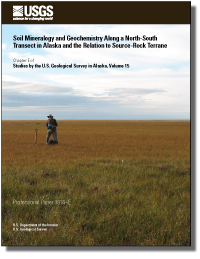Soil Mineralogy and Geochemistry Along a North-South Transect in Alaska and the Relation to Source-Rock Terrane
Links
- Document: Report (7.1 MB pdf)
- Larger Work: This publication is Chapter E of Studies by the U.S. Geological Survey in Alaska, Volume 15
- Appendixes:
- Appendix 1 (964 KB pdf) — Summary Statisitics for Chemical Analyses of Soil Samples from the North-South Transect of Alaska
- Appendix 2 (777 KB pdf) — Plots of mineral contents in soil samples from the upper and lower mineral soil horizons at sites along the north-south transect of Alaska
- Appendix 3 (4.1 MB pdf) — Box plots of elemental contents in soil samples at sites along the north-south transect of Alaska
- Appendix 4 (531 KB xlsx) — Mineralogical and chemical data for all transect soil samples, standard reference materials, and laboratory splits
- Download citation as: RIS | Dublin Core
Abstract
Soils collected along a predominately north-south transect in Alaska were used to evaluate regional differences in the soil mineralogy and geochemistry in the context of a geotectonic framework for Alaska. The approximately 1,395-kilometer-long transect followed the Dalton, Elliott, and Richardson Highways from near Prudhoe Bay to Valdez. Sites were selected with a site spacing of approximately 10 road-kilometers; soil was sampled by soil horizon at 175 sites. Terrane boundaries were estimated from digitized versions of the lithotectonic terrane map of Alaska (Silberling and others, 1994). Terrane assignments for each site were based on the site’s distance along the transect. We also present data for 15 minerals or mineral groups and 58 elements, as well as total, inorganic, and organic carbon. Quantitative mineralogy of the mineral-soil horizons was characterized by X-ray diffraction. Elemental contents were determined by a combination of inductively coupled plasma-atomic emission spectrometry (ICP-AES) and inductively coupled plasma-mass spectrometry (ICP-MS) analysis following a multi-acid or sodium-sinter decomposition of the samples. Total carbon and carbonate carbon contents were determined using an automated carbon analyzer and coulometric titration, respectively; organic carbon content was obtained by calculating the difference between total and carbonate carbon. Mercury and selenium were analyzed using cold-vapor atomic absorption (CV-AA), and hydride-generation atomic absorption spectrometry (HG-AAS), respectively. The mineralogical and geochemical patterns from these soils are used to assess the relation between soil characteristics and the geology of surrounding terranes.
Suggested Citation
Wang, B., Hults, C., Eberl, D., Woodruff, L., Cannon, W., and Gough, L., 2019, Soil mineralogy and geochemistry along a north-south transect in Alaska and the relation to source-rock terrane in Dumoulin, J.A., ed., Studies by the U.S. Geological Survey in Alaska, vol. 15: U.S. Geological Survey Professional Paper 1814–E, 27 p., https://doi.org/10.3133/pp1814E.
ISSN: 2330-7102 (online)
Study Area
Table of Contents
- Abstract
- Introduction
- Site Selection, Sampling, and Terrane Assignment
- Sample Preparation, Submittal, and Analysis Methods
- Data Summaries
- Using a Geotectonic Framework to Understand Regional Differences in Soil Mineralogy and Geochemistry
- Summary
- References Cited
| Publication type | Report |
|---|---|
| Publication Subtype | USGS Numbered Series |
| Title | Soil mineralogy and geochemistry along a north-south transect in Alaska and the relation to source-rock terrane |
| Series title | Professional Paper |
| Series number | 1814 |
| Chapter | E |
| DOI | 10.3133/pp1814E |
| Publication Date | August 12, 2019 |
| Year Published | 2019 |
| Language | English |
| Publisher | U.S. Geological Survey |
| Publisher location | Reston, VA |
| Contributing office(s) | Alaska Science Center Geology Minerals, Eastern Mineral and Environmental Resources Science Center |
| Description | Report: v, 27 p.; 4 Appendixes |
| Country | United States |
| State | Alaska |
| Online Only (Y/N) | Y |
| Additional Online Files (Y/N) | Y |


